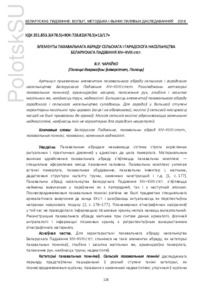Please use this identifier to cite or link to this item:
https://elib.psu.by/handle/123456789/23115Full metadata record
| DC Field | Value | Language |
|---|---|---|
| dc.contributor.author | Чараўко, В. У. | - |
| dc.date.accessioned | 2019-02-11T07:39:27Z | - |
| dc.date.available | 2019-02-11T07:39:27Z | - |
| dc.date.issued | 2018 | |
| dc.identifier.citation | Чараўко, В. У. Элементы пахавальнага абраду сельскага і гарадскога насельніцтва Беларускага Падзвіння ХIV–XVIII стст. / В. У. Чараўко // Беларускае Падзвінне: вопыт, методыка і вынікі палявых і міждысцыплінарных даследаванняў [Электронны рэсурс] : электрон. зб. навук. арт. ІV міжнар. навук. канф. да 50-годдзя Полацкага дзяржаўнага ўніверсітэта, Полацк, 19–20 крас. 2018 г. / Полацкі дзяржаўны ўніверсітэт ; пад агул. рэд.: А. І. Корсак. – Наваполацк, 2018. – С. 126-133. | ru_RU |
| dc.identifier.isbn | 978-985-531-617-7 | - |
| dc.identifier.uri | https://elib.psu.by/handle/123456789/23115 | - |
| dc.description | CHARAUKO, V. ELEMENTS OF THE FUNERAL CEREMONY OF THE URBAN AND RURAL POPULATION OF THE BELARUSIAN DVINA REGION OF THE 14th–18th CENTURIES | ru_RU |
| dc.description.abstract | Артыкул прысвечаны элементам пахавальнага абраду сельскага і гарадскога насельніцтва Беларускага Падзвіння ХIV–XVIII стст. Разгледжаны катэгорыі пахавальных помнікаў, арыенціроўка касцяка, палажэнне рук, глыбіня і засыпка магільных ям, наяўнасць трун, надмагіллі. Большасць элементаў пахавальнага абраду гарадскога і сельскага насельніцтва супадаюць. Для гарадоў у большай ступені характэрны могільнікі пры цэрквах (хаця і не абавязкова), могілкі ў сельскай мясцовасці часцей не былі прывязаны да храмаў. Многія сельскія могілкі адрозніваюцца каменнымі надмагіллямі, наяўнасць якіх не характэрна для гарадскіх некропалей.=The article is devoted to the elements of the funeral ceremony of the rural and urban population of the Belarusian Dvina region of the 14th–18th centuries. The categories of funerary monuments, the orientation of the skeleton relative to the cardinal points, the position of the arm bones, the depth and a filling of a grave pits, the presence of coffins and tomb structures are considered. Most of the elements of the funeral ceremony of the urban and rural populations are the same. For towns, churchyards are more, though not necessarily, and for the countryside, cemeterys. Many rural cemeteries are distinguished by gravestone constructions, the presence of which is not typical for urban necropolises. | ru_RU |
| dc.language.iso | be | ru_RU |
| dc.publisher | Полоцкий государственный университет | ru_RU |
| dc.relation.ispartof | Беларускае Падзвінне | be_BE |
| dc.subject | Государственный рубрикатор НТИ - ВИНИТИ::ОБЩЕСТВЕННЫЕ НАУКИ::История. Исторические науки | ru_RU |
| dc.subject | Государственный рубрикатор НТИ - ВИНИТИ::ГРАМАДСКІЯ НАВУКІ::Гісторыя. Гістарычныя навукі | ru_RU |
| dc.subject | Беларускае Падзвінне-2018 | ru_RU |
| dc.subject | Пахавальны абрад ХIV–XVIII стст. | be_BE |
| dc.subject | Пахавальныя помнікі | be_BE |
| dc.subject | Пахаванні | be_BE |
| dc.subject | Каменныя надмагіллі | be_BE |
| dc.subject | Belarusian Dvina region | - |
| dc.subject | funerary monuments | en_EN |
| dc.subject | burials | en_EN |
| dc.subject | gravestone constructions | en_EN |
| dc.subject | funeral ceremony of the 14th–18th centuries | en_EN |
| dc.title | Элементы пахавальнага абраду сельскага і гарадскога насельніцтва Беларускага Падзвіння ХIV–XVIII стст. | ru_RU |
| dc.type | Article | ru_RU |
| Appears in Collections: | Беларускае Падзвінне. 2018 | |
Files in This Item:
| File | Description | Size | Format | |
|---|---|---|---|---|
| Чараўко_с126-133.pdf | 159.24 kB | Adobe PDF |  View/Open |
Items in DSpace are protected by copyright, with all rights reserved, unless otherwise indicated.